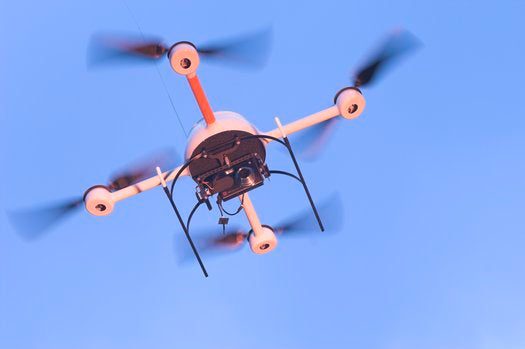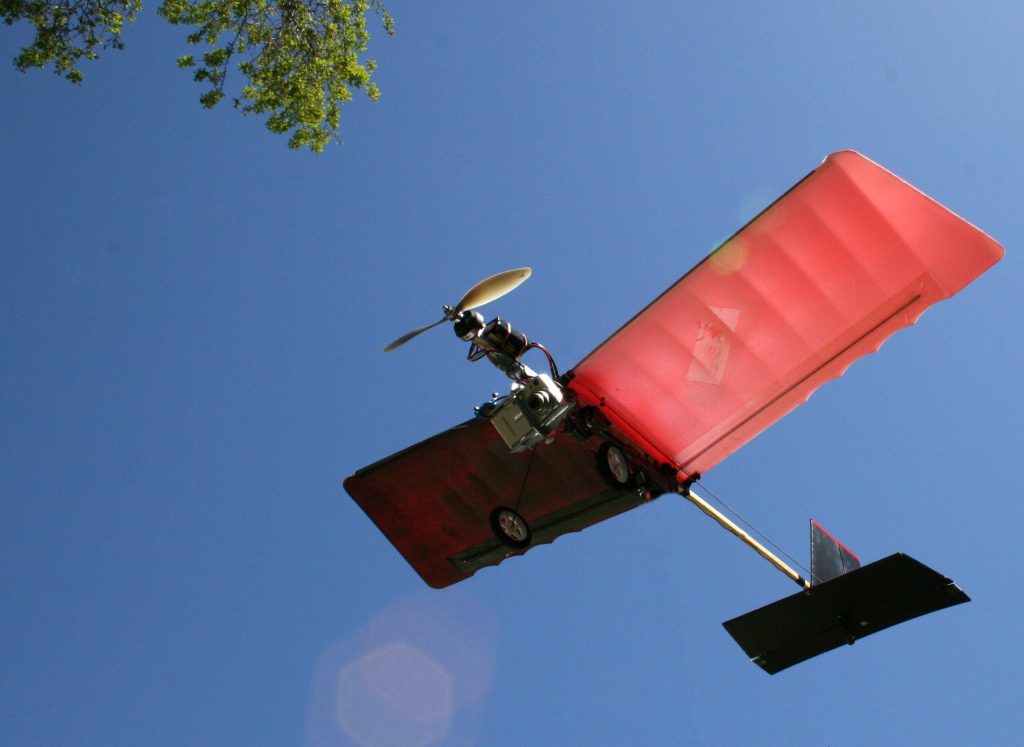On a hazy day last January, an unmanned aircraft enthusiast piloted his camera-equipped drone in the vicinity of a Dallas meatpacking plant, cruising around 400 feet in the air. To test his equipment, he took some photos of the Trinity River with a point-and-shoot camera mounted to his $75 foam airframe. When he retrieved the remote-controlled aircraft, he noticed something odd in the photos: A crimson stream, which appeared to be blood, leaking into a river tributary.
The pilot, whose name has not been released, notified Texas environmental authorities, who launched an investigation. On Dec. 26, a grand jury handed down several indictments against the owners of the Columbia Packing Company for dumping pig blood into a creek. They now face hefty fines and even prison time stemming from the water pollution, and the plant has since been shuttered. Neighbors had complained about noxious fumes and other issues for a while, according to the local news. But investigators didn’t get involved until this drone pilot took his pictures.
Under a new law proposed in the Texas legislature, sponsored by a lawmaker from the Dallas suburbs, this type of activity could soon be criminal. Not the pollution–the drone.
Texas House Bill 912–and similar laws under debate right now in Oregon and elsewhere–are driving a burgeoning debate about how to use and control unmanned air systems, from an AR.Drone to a quadcopter. The Federal Aviation Administration is in the process of drafting new rules governing unmanned aircraft in civilian airspace, including military-style aircraft. But in the meantime, plenty of cheap, easy-to-use aircraft are already popular among hobbyists and, increasingly, activists and law enforcement.
Drones don’t have to be Predators to cause privacy concerns, in other words. In recent months, they’ve led to new legislative action in California, Florida, Missouri, North Dakota, Oregon and Virginia.
Texas state Rep. Lance Gooden, a Republican, is the sponsor of the latest bill, which would make it a misdemeanor to take photos with an unmanned aircraft. It’s unique because it criminalizes taking any data–photos, sound, temperature, even odor–of private property using an unmanned aircraft without the permission of the property owner. Law enforcement officers could only use drones while executing a search warrant or if they had probable cause to believe someone is committing a felony, and firefighters can only use drones for fighting fire or to rescue a person whose life is “in imminent danger.” Texas’ border-patrolling Predator drones are exempt within 25 miles of the Mexican border. There are additional penalties for possession, display or distribution of data captured by an illegally flown drone. Gooden said the goal is to protect Texans’ privacy.
For most people, when you say unmanned aerial vehicle, they think the Department of Defense–‘Oh man, the Predator, that one with the missile on it.’ That’s the disconnect.
“We’re not trying to get rid of drones; drones can be used for great purposes. We’re not trying to interfere with hobbyists’ use of drones. But you have a right to privacy on your property,” he said in an interview.
Ben Gielow, general counsel and government relations manager for the Association for Unmanned Vehicle Systems International, countered that limiting privacy concerns to unmanned aircraft makes little sense. “The response would be, what about manned aircraft doing the same type of mission, taking the same pictures? What about satellites and Google Earth?” he said. “What’s the difference if you have a picture from a manned aircraft or an unmanned aircraft? This is really a data issue; it’s about how the data is going to be used. So let’s have a conversation about that.”
He and other drone experts said the bill demonstrates how much drones are misunderstood in this country, and underscores why hobbyists and aircraft makers should be taking a more active role in explaining the technology’s potential benefits. Gielow and others described unmanned aircraft as simply another tool, easily, cheaply and legally used by law enforcement and civilians for a host of reasons.
“Just like any tool, yes it could be abused and used to do wrong. We need to ensure that there is transparency and accountability with the folks that use this technology,” Gielow said. “An outright ban, I think, would be a shame–not only for this new industry, but also for all the potential applications to do good.”
Those applications are numerous, according to Patrick Egan, an editor at the unmanned systems news site SUAS News and a civilian researcher for the U.S. Army Space and Missile Defense Command. Organic farms could use aerial surveillance to monitor crop health and target insect or weed infestations, he said. Ecologists and animal welfare agencies could use them to hunt down poachers and monitor savannah wildlife. The U.S. Geological Survey, which has a vibrant drone program, uses unmanned aircraft to look at fault zones, woodlands, wildfires, invasive species and more. Ranchers could use it to monitor rangeland; environmental agencies could use it for air sampling; and developing countries could use it to check crop health. The drone industry just has an image problem, Egan said.
“For most people, when you say unmanned aerial vehicle, they think the Department of Defense–‘Oh man, the Predator, that one with the missile on it,'” Egan said. “The public has a perception of the military spying and taking out al Qaeda, and to me that’s the disconnect. People don’t understand that you can feed a hungry world with this technology, you can do public and private asset management, you can do a myriad of good things with this technology that don’t get press.”

Microdrone
Gooden said he doesn’t want to limit beneficial drone uses, from law enforcement pursuing criminal suspects to power companies checking downed lines. “But under no circumstances, ever, should people lose their right to privacy just because people want to take pictures,” he said.
These are bipartisan concerns, evidenced by the involvement of Gooden’s Senate cosponsor, Democratic state Sen. John Whitmire, and in Oregon anyway, the American Civil Liberties Union. “We are not and should not be a surveillance state. Drones should never be used for mass surveillance,” Becky Straus, legislative director of the ACLU’s Oregon office, told U.S. News & World Report.
Todd Humphreys, director of the Radionavigation Laboratory at the University of Texas at Austin and a hobbyist who uses quadcopter drones for research, said he can sympathize with that worry, especially as drones become more ubiquitous. But it’s complicated.
“If there are folks operating on private land, flying over it and taking pictures, that would bother me, if it were my backyard or my barbecue or whatnot. So I sympathize with people who would find that intrusive,” he said in an interview. “But the legislation doesn’t discriminate between ill intent and intent to surveil, and incidental surveillance. If I am doing research on university lands, and I pitch my quadcopter in a banking maneuver, there’s definitely private land out there in the field of view of my camera right now. And it’s this incidental byproduct of my fairly innocent mission that is getting me crosswise with the law.”
That’s interesting because that type of incidental surveillance is exactly what led to the bloody river discovery. Had the Dallas hobbyist not been taking pictures of the river–which, as Gooden pointed out, is a public waterway–he never would have seen the illegal activity.
“The idea of slaughterhouse waste going out in the drinking water, that’s not cool,” said Egan. “What is cool is that these people are being indicted on these charges because of that picture. He was just out there tooling around with his equipment.”
Gooden maintains that the hobbyist could have deleted any pictures showing private property and notified authorities, who would have then had probable cause for a search. “But if he decides he wants to move his drone over private property, that is not something that would be admissible under this bill,” Gooden said.
Laws governing airspace are already complex, and adding new layers specific to drones are unlikely to clarify matters. In its 1946 decision in United States v. Causby, the U.S. Supreme Court declared navigable airspace to be “a public highway” and within the public domain. Because of this, there’s no reason why a privately owned human-occupied aircraft can’t fly over private property. What’s more, federal laws and court doctrines hold that Americans should have no expectation of privacy in publicly viewable spaces, as Gielow put it. They do in homes and covered areas, but not open land.
Gooden countered that drones expand access–you’d hear a manned airplane or helicopter–and they glimpse areas and activities that would otherwise be invisible from a public vantage point. “If you have a ranch, you can pretty much expect that there are areas of your property that are not going to be visible to anyone. In a city, there are areas of maybe your back porch or windows that people can’t peer into,” he said. “But with these drones, you can come into someone’s back yard, turn on a camera and film their every move. This bill would simply say that’s not acceptable.”
While the FAA and state lawmakers continue to tackle the problem, drone operators and private landowners seem to have reached at least one possible solution. About two weeks after the bloody river discovery, an animal rights group flew a microdrone above private property in South Carolina, aiming to film what they said was a live pigeon shoot. The shoot never took place, but a low-caliber gunshot did take down the drone.
Humphrey said that’s a “Texas solution.”
“I say go ahead and fly drones over private property, and those who own it are legally entitled, if they wish, to try to shoot down your drone,” he said, only half kidding. “Let the market decide.”









